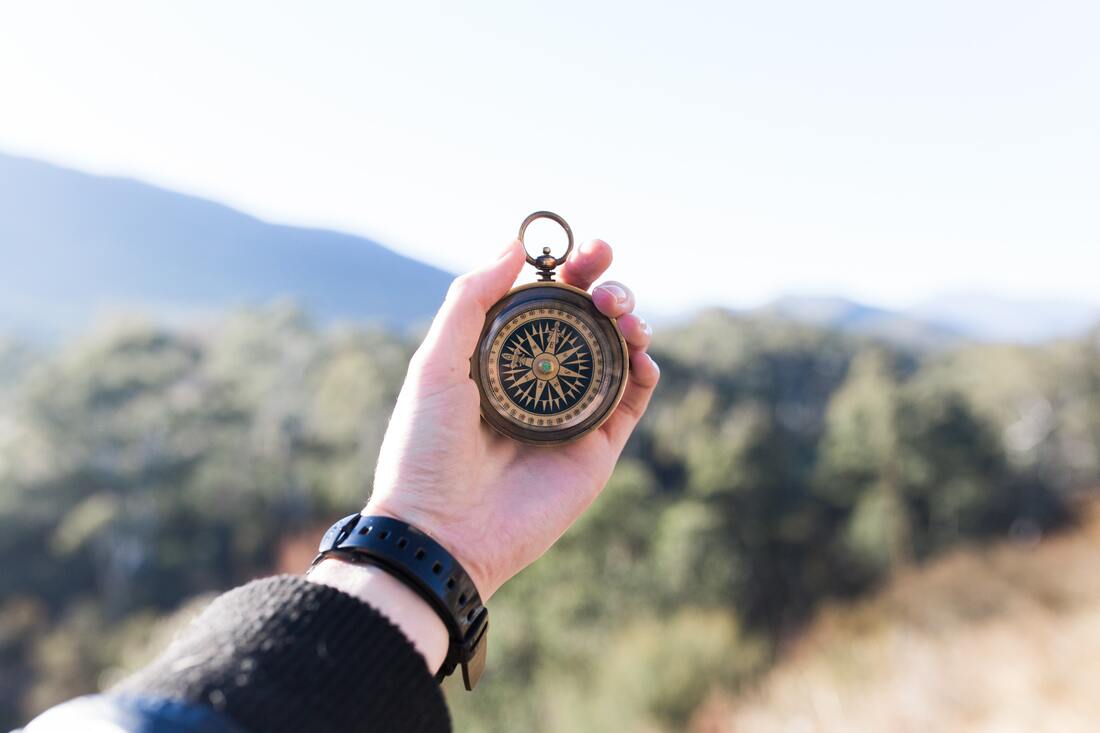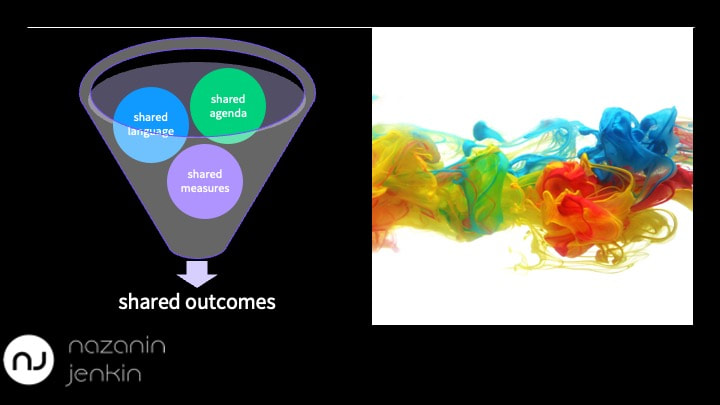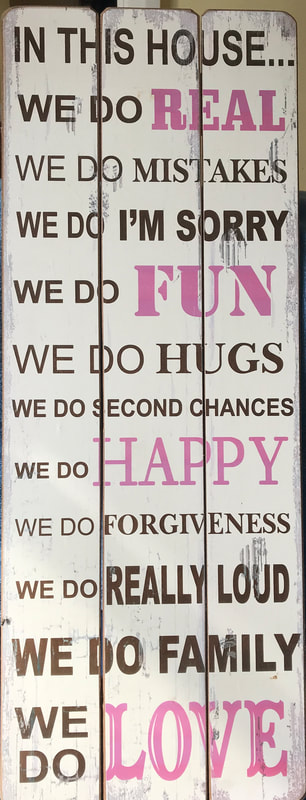I'm thinking about... |
|
Building on my recent posts...Recently I've had a number of conversations that have reminded me there are some elements of Collaboration and Collaborative Leadership that are not 'obvious'- so we need to be more explicit. I get it: I immersed myself in the research and it took me years to begin to put words around the ideas, which are continually evolving - but not everyone is geeky in this field! So, because I'm on a mission to grow a collaborative movement that delivers shared value - I am going to offer here some of the ideas that we continue to explore and debate in my workshops with regard to Collaboration and Collaborative Leadership. The first idea was: An edict to collaborate doth not collaboration make. The second idea was: Our role as leaders and facilitators in the arena of collaboration, partnerships and joint ventures is to convene spaces where all the voices can be heard. Here's the third idea: We need to be working together with shared measures. More often than not we measure what we can or just what we have historically. I've led many a strategy and strategic planning process with associated KPI's and been contracted in more than once to review an organisation's measures. When I've inquired around those measures, most frequently folk don't know why they measure what they do nor the value it adds to the strategic direction. Generally they talk to the process of measuring or the movement in the measure over time (up/down). I've worked across sectors and departments - the pattern of response is similar. Whatever the measures, my observation has been that the measures become the incentives and drive behaviours. These measures than act as key 'constraints' or 'levers' in the system. They determine what we invest in, where we put our energies and how we work. Sometimes that's limiting, sometimes that can be enabling. e.g. we've got too much 'x' let's get that number down or we need more 'y' , let's invest in getting us closer to the 'desired' number. Measures impact decision-making and behaviours. "Tell me how you measure me, and I'll tell you how I'll behave," said Goldratt But one thing is for sure if the measure 'we are' chasing is different to the measure 'you are' chasing or 'they are' chasing, then we're likely to be in conflict. We'll be pushing for and driving different agendas. It may be that these measures across our teams/departments/organisations are complementary, but often they're not or we just don't know, because no-one has really considered how the measures interrelate (if at all). Importantly, in the field of collaboration and partnerships and joint ventures, they are a 'cog in the wheel' 0f successfully working together or not, as the case may be. When we come together in collaborative partnership or joint venture we need to reframe and rest towards shared measures. What are we journeying towards and how can we measure this together? Would it surprise you if I said I have yet to work with any partnership group or organisation working towards strategic collaboration that already has shared measures in place? I'm sure there must be some... When we work together to reset towards a shared agenda, with a shared language and shared measures - the behaviours change - the stories change - the relationships change - the culture changes - and, the outcomes change. An opportunity: My observation would be that for us here in New Zealand, the Public Service Act 2020 is one platform that could potentially encourage development of shared measures towards supporting public service agencies to work more collaboratively and as a system. Maybe you know of examples where this is already happening? If so I'd love to hear about them.
0 Comments
Building on my recent post...
Recently I've had a number of conversations that have reminded me there are some elements of Collaboration and Collaborative Leadership that are not 'obvious'- so we need to be more explicit. I get it: I immersed myself in the research and it took me years to begin to put words around the ideas, which are continually evolving - but not everyone is geeky in this field! So, because I'm on a mission to grow a collaborative movement that delivers shared value - I am going to offer here some of the ideas that we continue to explore and debate in my workshops with regard to Collaboration and Collaborative Leadership. The first idea was: An edict to collaborate doth not collaboration make. Here is the second: Our role as leaders and facilitators in the arena of collaboration, partnerships and joint ventures is to convene spaces where all the voices can be heard. Warning: this is generally not a "harmonious", meditative retreat type process - it gets messy and is regularly confrontational and often noisy! BUT - and it's a big BUT - when we take time to be in community together, to talk and listen without judgement and then debate and discourse, for as long as it takes - often around shared food and drink - 'magic' happens :-) Ideas emerge that appeared unimaginable a short time earlier, and we come to a point where we can work together with shared understanding towards a common purpose. This way of working and being and becoming are intertwined in the traditions passed on through the generations across many indigenous cultures. As a Persian I was raised in the traditions of the sufi tea houses and over the past two decades I've had the privilege to be part of a number of noho marae stays and hui. Here are some things I've learnt: ➡️We need to take the time needed - there's no rushing this stuff. Figuratively or literally: take your shoes off, settle down on the carpet, be comfortable - we might be here a while. ➡️Listening and withholding judgement, with respect and generosity, are key success anchors. ➡️A lot of personal internal work goes on between the ears as we listen. ➡️Differences of opinions and diversity of thought are welcomed and encouraged. ➡️It can often get loud, sound heated and feel/be confrontational - especially if folk are passionate about a perspective or idea. ➡️There's no space for ego - park it at the door. ➡️Those used to power and control will struggle - it's pretty much a given. ➡️Everyone is going to arrive at the table (actually, wherever possible now I remove the 'physical' table!) with a pre-set agenda...you should see the individual pre-workshop emails I always get! That's ok - it's just a starting point and it's useful to know where we are all at. ➡️Be prepared: we'll have a process and framework, but we're not going to follow a tidy meeting agenda in this workshop. ➡️It's not about the destination, it's a journey and we work together to agree 'the direction' we are going to journey on. ➡️Spending time together in community - over kai or breaking bread together and perhaps shared a drink (where appropriate) - is important. If you think cutting out the organisation's cheese scones or other hospitality budget is a good quick win towards efficiency and effectiveness, think again. Generous hospitality glues community together. ➡️Just as we arrive with different agendas, we arrive with different cultures. What's 'normal' or 'accepted' by one will not necessarily be by another. Through the process a shared culture will emerge. ➡️In the end, it's all about the people and relationships - but process matters and makes a difference. Recently my husband and I were walking our dogs in our local park. There was a fair bit of noise coming from one area and we saw people staring. Superficially, to some, it may have appeared heated and that things were not 'in order'. A lively group of Mums and children were having a picnic, and it probably didn't look like a traditional Plunket group or others Mums' group in NZ. This was a group of Mums and children from our local Middle Eastern community. My people. A bit loud, everyone talking over each other, very little 'evident' order. Of course it was 'ordered' exactly as it needed to be - everyone was safe and well taken care of. When you looked with an open mind and heart, obviously a load of fun was being had by all. It was a beautiful scene to behold! Tim (my husband) and I began talking and pondering how this scene could have appeared different to different people. Some 30+ years ago, when he first met my whānau and we gathered across multiple events together to celebrate our forthcoming marriage - it was a bit of a culture shock to him. There was a A LOT of noise and food - often raised voices and loud music!!! Similarly, when I met his whānau it was a different culture shock for me (perhaps a little less so, as I had lived in the UK for some twenty years by then). In truth, in the intervening period, we have frequently (and at times, daily) had to consider together cultural nuances and work to come to a shared understanding of what is being said, what is meant and what that may imply for future actions and decisions. You could say, we are constantly in a collaboration framework. If you know us personally and have sat with us at a family meal, you'll know debate and discourse is the norm. We are all the richer in our relationships together for it. Just like a collaboration workshop: sometimes it gets a bit messy and a bit noisy, often there are differences of opinions - but always, we leave in community a little better for the time we have spent together. Below is a picture of a plaque that greets you as you walk into our home. Perhaps in our collaboration mahi together we could replace the start with ... 'In this hui...' |
Nazanin jenkinNazanin Jenkin Archives
September 2021
Categories
All
|



